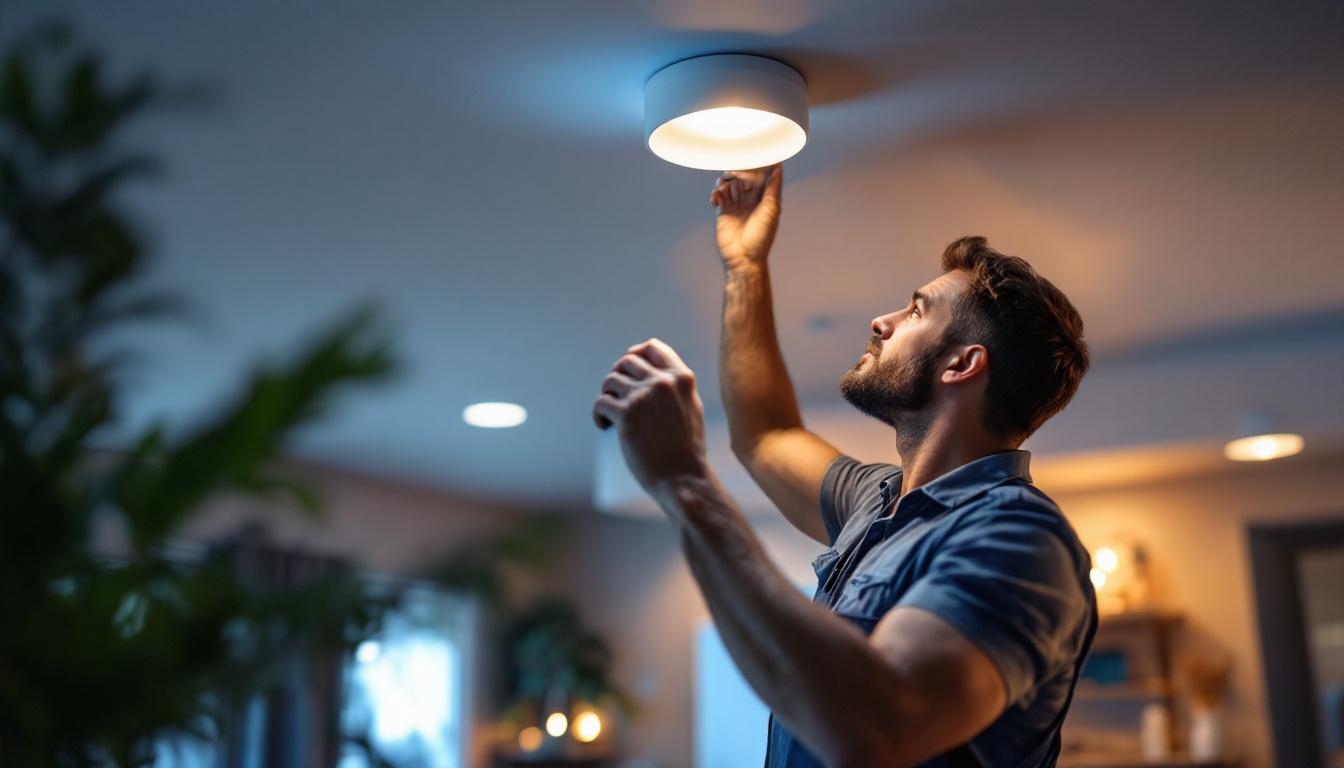
recessed ceiling lighting, often referred to as can lighting or pot lighting, has become a staple in modern interior design. This type of lighting is embedded into the ceiling, providing a clean and unobtrusive look while effectively illuminating spaces. For lighting contractors, understanding the nuances of recessed ceiling light bulbs is essential for successful installations and satisfied clients.
These fixtures are not only about aesthetics; they also play a crucial role in energy efficiency and functionality. The right choice of bulbs can enhance the overall ambiance of a room, making it vital for contractors to stay informed about the latest technologies and trends in recessed lighting. Moreover, the integration of smart lighting systems has transformed how recessed lights can be controlled, allowing homeowners to customize their lighting experience through mobile apps or voice commands, which adds another layer of appeal for modern installations.
Selecting the appropriate bulb for recessed lighting can be challenging due to the variety of options available. From LED to halogen, each type offers unique benefits and drawbacks. For instance, LED bulbs are known for their energy efficiency and longevity, while halogen bulbs provide a warmer light but consume more energy. Additionally, there are also compact fluorescent lamps (CFLs) that offer a middle ground, providing decent energy savings but with a slower warm-up time compared to LEDs.
Contractors must consider the specific needs of each project, including the desired brightness, color temperature, and energy consumption. Understanding these factors can help in making informed decisions that align with client expectations and project requirements. The color rendering index (CRI) is another critical aspect to consider, as it affects how colors appear under different lighting conditions. A higher CRI rating ensures that colors look more vibrant and true to life, which is particularly important in spaces like kitchens or art studios where color accuracy is paramount.
Lighting contractors often face several challenges when installing recessed ceiling lights. One of the most common issues is determining the correct placement of fixtures to achieve optimal lighting without creating shadows or overly bright spots. This requires a keen understanding of the space and the intended use of the lighting. Factors such as ceiling height, room dimensions, and the presence of furniture can all influence the effectiveness of the lighting layout.
Another challenge is ensuring compatibility between the fixtures and the chosen bulbs. Each fixture has specific wattage and size limitations, and using the wrong bulb can lead to performance issues or even safety hazards. Contractors must be diligent in verifying these specifications to avoid costly mistakes. Furthermore, they should be aware of local building codes and regulations regarding electrical installations, as these can vary significantly and may impact the overall design and safety of the lighting project. Proper planning and consultation with clients can help mitigate these challenges, ensuring a smooth installation process and a beautifully lit space.
As energy efficiency becomes increasingly important, lighting contractors must prioritize this aspect in their projects. Recessed lighting can consume a significant amount of energy, especially when using traditional incandescent or halogen bulbs. Transitioning to LED technology not only reduces energy consumption but also lowers long-term costs for clients.
Furthermore, educating clients about the benefits of energy-efficient options can enhance their satisfaction and trust in the contractor’s expertise. Providing clear comparisons between different bulb types and their energy usage can help clients make informed decisions.
Smart lighting solutions have gained popularity in recent years, offering enhanced control and customization for homeowners. Integrating smart recessed lighting can provide clients with the ability to adjust brightness, color, and timing through mobile apps or voice commands.
Contractors should familiarize themselves with various smart lighting systems and their compatibility with recessed fixtures. This knowledge not only broadens the contractor’s service offerings but also positions them as forward-thinking professionals in a competitive market.
Technical challenges often arise during the installation of recessed lighting. Issues such as ceiling height, insulation, and existing electrical systems can complicate the process. For instance, in homes with low ceilings, the depth of the recessed fixture must be carefully considered to avoid a cramped feeling.
Additionally, navigating local building codes and regulations is essential. Contractors must ensure that all installations comply with safety standards and electrical codes to avoid potential liabilities. Staying informed about local regulations can save time and prevent issues down the line.
Recessed lighting is not just about functionality; it also plays a crucial role in enhancing the aesthetic appeal of a space. The right lighting can highlight architectural features, create focal points, and set the mood for different areas within a home.
Contractors should consider collaborating with interior designers to create cohesive lighting plans that align with the overall design vision. This collaboration can lead to innovative solutions that elevate the quality of the project and meet client expectations.
The trim and finish of recessed lighting fixtures can significantly impact the overall look of a space. Options range from baffle trims that reduce glare to adjustable trims that allow for directional lighting. Each choice can influence not only the functionality but also the aesthetic of the room.
Contractors should be well-versed in the various trim options available and their respective benefits. Providing clients with samples or visual aids can help them visualize the final outcome and make more informed decisions.
Color temperature is another critical factor in recessed lighting design. Bulbs are available in a range of color temperatures, typically measured in Kelvin (K). Warmer tones (2700K-3000K) create a cozy atmosphere, while cooler tones (4000K-5000K) are often preferred for task-oriented spaces.
Understanding the psychological effects of color temperature can help contractors recommend the best options for different areas of the home. For example, a warmer light may be ideal for living rooms, while a cooler light may be more suitable for kitchens or workspaces.
Effective communication with clients is paramount in overcoming challenges associated with recessed ceiling lighting. Many homeowners may not fully understand the intricacies of lighting design, making it essential for contractors to educate them on the options available and the implications of their choices.
Providing detailed explanations about the benefits of different bulb types, energy efficiency, and aesthetic considerations can empower clients to make informed decisions. This not only enhances their satisfaction but also builds trust and credibility for the contractor.
Visual aids can be powerful tools in client education. Using diagrams, charts, or even virtual simulations can help clients visualize how different lighting options will affect their spaces. This approach can clarify complex concepts and facilitate better decision-making.
Additionally, showcasing previous projects or case studies can demonstrate the contractor’s expertise and the potential outcomes of various lighting choices. This not only instills confidence but also encourages clients to explore innovative solutions.
After the installation is complete, following up with clients can provide valuable insights into their satisfaction and any challenges they may have encountered. This feedback can be instrumental in improving future projects and addressing any lingering concerns.
Establishing a feedback loop not only enhances client relationships but also positions the contractor as a dedicated professional who values their clients’ experiences. This commitment to service can lead to repeat business and referrals, essential components of a successful lighting contracting business.
The lighting industry is constantly evolving, with new technologies and trends emerging regularly. For lighting contractors, staying informed about these changes is crucial for maintaining a competitive edge. This includes understanding advancements in bulb technology, energy efficiency standards, and design trends.
Attending industry conferences, participating in training sessions, and subscribing to relevant publications can help contractors keep their skills sharp and their knowledge current. Embracing innovation not only benefits contractors but also enhances the overall quality of their work.
Building relationships with other professionals in the industry can provide valuable insights and opportunities for collaboration. Networking with electricians, interior designers, and architects can lead to referrals and partnerships that benefit all parties involved.
Engaging in local trade associations or online forums can facilitate knowledge sharing and foster a sense of community among lighting contractors. This collaborative spirit can lead to innovative solutions and improved practices across the industry.
As sustainability becomes a priority for many homeowners, lighting contractors must consider eco-friendly practices in their work. This includes recommending energy-efficient bulbs, utilizing sustainable materials, and minimizing waste during installations.
Contractors who embrace sustainability not only contribute to environmental conservation but also appeal to a growing market of eco-conscious consumers. Highlighting these practices in marketing materials can attract clients who prioritize sustainability in their purchasing decisions.
Recessed ceiling light bulbs present both opportunities and challenges for lighting contractors. By understanding the intricacies of bulb selection, energy efficiency, aesthetic considerations, and effective client communication, contractors can navigate these challenges successfully.
Staying informed about industry trends and embracing innovation will further enhance the contractor’s ability to deliver high-quality lighting solutions that meet the evolving needs of clients. Ultimately, a commitment to excellence in recessed lighting can lead to satisfied clients, repeat business, and a thriving contracting business.
Ready to elevate your lighting projects with the highest quality recessed ceiling light bulbs? At LumenWholesale, we provide lighting contractors like you with spec-grade lighting products at exceptional wholesale prices. Say goodbye to local distributor markups and hello to a vast selection of reliable lighting solutions that meet rigorous industry standards. With free shipping on bulk orders, you can stock up on premium lighting without worrying about hidden fees. Make your next project shine with Wholesale Lighting at the Best Value from LumenWholesale, where quality, affordability, and convenience come together seamlessly.

Discover how LED replacements for fluorescent bulbs can enhance profitability in lighting installations.

Discover how ceiling hall lights can be a game-changer for lighting contractors looking to win more bids.

Discover how top lighting contractors leverage innovative light sensor pull chain technology to enhance efficiency and design.

Discover top places to buy LED bulbs with real-world success stories for lighting contractors.